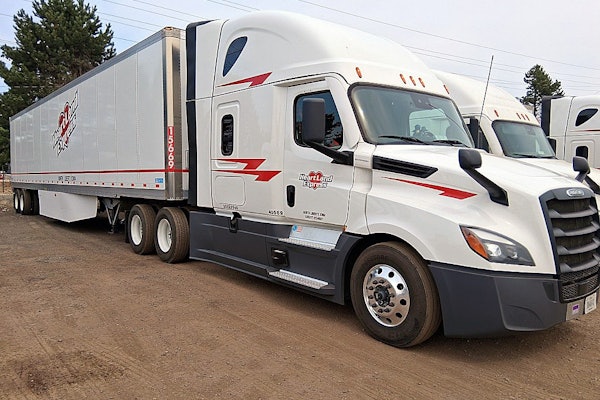If you liked 2004, how about another one? The consensus among economic analysts is that growth will be solid in 2005, although perhaps not quite as strong as it was in 2004. But slower growth is still growth, and demand still will likely outpace capacity as carriers continue to face labor shortages and other constraints.
“I see our operations in 2005 growing probably in the area of 10 percent,” says Michael Ward, vice president of Altoona, Pa.-based Ward Trucking Corp. “We are continually faced with driver and mechanic shortages for both our truckload and LTL operations as well as the issues with high fuel costs, but I continue to see more and more freight being available.”
For companies like Ward Trucking, a lack of qualified drivers is one of the biggest limiting factors on growth. In a recent survey of CCJ readers, 62 percent said that the driver shortage was their top constraint on growth. Judging by record turnover, carriers that did get drivers largely stole them from others.
With the scope of growth constrained by driver availability, many carriers will focus on improving their customer base and continuing to recover from the effects of the lean years leading into today’s boom times.
“I’m optimistic,” says Ed Trout, president of Omaha, Neb.-based Cornhusker Motor Lines. “We’ve been turning down a lot of freight lately. We’re gearing up with a good driver contract to get some more of the freight that’s out there, but we won’t grow much. What we really want to do is pay for some sins – pay off debt and improve our infrastructure.”
Weak dollar, strong economy
“Demand has been and will continue to be robust,” says Donald Broughton, transportation equities analyst for A.G. Edwards. He attributes strong demand to a “manufacturing renaissance” – the healthiest period since the end of the 1982 recession.
What’s behind this rebirth in manufacturing? Broughton lists several factors, including low interest rates, tax breaks and a devaluation of the dollar over the past couple of years.
A weak dollar makes U.S. exports more attractive, and it operates as a tariff on imported goods to encourage manufacturers to use suppliers based in the United States, Broughton says. To date, the effects of the weakening dollar have been nothing but positive. An extended period of weakening can be inflationary, but there are no signs of that yet. “It’s the dollar, stupid,” Broughton says.
Bob Costello, chief economist of the American Trucking Associations, agrees that currency devaluation is playing a role in the strong economy and, in turn, today’s healthy freight volumes. “Manufacturers like the weakening dollar.” But one consequence of the weak dollar is that imports are starting to slow a little, and that’s not great news for carriers that depend on them, Costello says.
Broughton also points to an upward revision in Gross Domestic Product for the third quarter as a reason to be bullish on the coming year. It wasn’t the degree of the adjustment that’s so reassuring, he says. It’s the reason. Investment in manufacturing equipment and tools and dies was greater than originally estimated, and exports were higher than original estimates.
Still, most observers see slower growth. “I do think we have seen a deceleration of demand growth in the fall period,” Costello says. He adds, however, that it’s “something that quite frankly I’m not too worried about.” Manufacturing, while strong, is starting to decelerate, he says. One reason Costello isn’t concerned is that the slower growth is on top of very strong growth earlier.
“We expect that the economy in 2005 will be good but not great,” says Ken Kremar, trucking industry analyst for economic research firm Global Insight. The firm is projecting 3.5 percent growth in GDP, down from 4.5 percent this year. Consumer spending likely will lag behind that level, with capital spending and trade exceeding 3.5 percent growth, Kremar says. This year “won’t be as good a year in terms of growth, but it should be a pretty good year for trucking companies.”
All sectors of the economy look good, Kremar says. One area of some softness will be housing starts, which are projected to drop to 1.8 million units from last year’s 1.96 million units. But 1.8 million units still is very strong, he says. Plus, non-residential construction is expected to grow.
By the time you read this, the tone for 2005 already may be set, argues Chris Brady, president of economic research firm Commercial Motor Vehicle Consulting Inc. If consumer spending met or exceeded retailers’ expectations, that would imply that inventories are in line throughout the supply chain, and there shouldn’t be disruptions in transportation. But if holiday sales were well below expectations, that would suggest that current inventories exceed demand, resulting in lower production.
Drivers of success
Even if these forecasts prove optimistic, trucking companies still may be poised for a great year.
“When you throw in the supply side, that’s when trucking starts to look good,” Costello says. “I do think that there is marginal capacity being added, but it’s not growing as fast as tonnage.”
As noted earlier, carriers point to lack of drivers as their top constraint on growth. That’s certainly the experience at Rushville, Ind.-based Fraley and Schilling. “Drivers are unwilling to take a job that pays only when you run, while a big percentage of their time is spent waiting at docks,” says Dave Glenn, vice president of operations. “They feel it’s better for them to go into a factory and work than to take a job for a trucking company right now.”
“No one has yet to find a driver pay rate to bring in more drivers,” Broughton says. “The industry will continue to try to solve the driver problem through pay, but that’s not all of the solution.”
A number of carriers have announced pay increases for the coming year. Schneider National, for example, is raising the income of company drivers by an average of $4,000. And it’s also offering a number of “work-life” improvements, such as more opportunities for home time and predictable schedules. And yet, no one expects such moves to solve the problem of driver supply.
Another issue is the build rate for trucks. “We are building a sufficient number of trucks to get the average age of the nation’s fleet back to where it needs to be,” Broughton says. “We’re completely in replacement mode.” Broughton acknowledges that many of those replaced trucks go into the secondary market, but he doesn’t believe it adds significantly to the capacity for on-highway freight transportation because the older trucks no longer are reliable enough for that application. “Who cares if [the truck] is still out there?”
Brady disagrees, arguing that just as buyers of new trucks have become accustomed to older fleets, so have buyers of used trucks.
The price is right
When supply lags behind demand, the price will rise. Freight rates have been rising for some time and likely will continue, analysts say.
“Pricing has been very strong,” Broughton says. Rates for publicly traded truckload carriers are up 8.1 percent through the third quarter of 2004 compared to the 2003 period. “And this is happening in an industry in which 3 to 4 percent is very good.” Part of that success resulted from the panic carriers instilled in their customers over the new hours-of-service regulations. “The hours-of-service rules did not create as much disruption because they changed behavior.”
Broughton doesn’t see profits rising any faster in 2005 than in 2004, given high fuel prices and increasing costs of equipment. “And whatever pricing improvements that aren’t consumed by increases in operating costs will be dedicated to raising driver pay.”
Tight capacity also has created a fluid environment for business development. “This is an opportunity for carriers to think strategically,” Brady says. “Who are your marginal customers? It’s an opportunity to go after freight and drop marginal customers and to address lane imbalances.”
The message is, don’t just enjoy the good times, use them to your long-term advantage.
–Aaron Huff contributed to this article
What’s the outlook for 2005?
“I believe the outlook for all carriers is very strong. The demand for freight is way up. Rates continue to rise. We still fight the cost of fuel on a routine basis, and I believe that at one point in the future, and fairly shortly, rates will be bumped up to eliminate a good share of the fuel surcharge.”
Reed Baldwin, vice president and general manager
Miller Brothers Inc., Hyrum, Utah
“I’m very optimistic about freight volumes, rates and controlled costs. I think these things could turn out to be in place for the long term.”
Keith Tuttle, president
Motor Carrier Service, Northwood, Ohio
“We look to be extremely busy and still growing. We grew probably 20 percent or more this year, and next year looks to be about the same. Hours-of-service problems and fuel are still major concerns.”
Dave Glenn, vice president of operations
Fraley and Schilling, Rushville, Ind.
“We’re cautiously optimistic. Unless something really drastic happens from a terrorist standpoint – which I think a lot of people have in the back of their minds – I don’t see the economy doing a real tailspin. Fuel prices are hurting everybody. They are so volatile right now. I foresee that continuing on through most of 2005.”
Bob Roullier, CEO
Davis Transport Inc., Missoula, Mont.
“Our outlook is very positive from all of the customers we’ve talked to. They are expecting demand to continue, especially for flatbeds, which is the business we’re in. We’re certainly going to try to grow, but that is keyed around our ability to recruit owner-operators. That is a challenge and a hurdle for us, but I’m confident that we are going to be able to grow and add to our truck fleet.”
Gary Salisbury, senior vice president and COO
Fikes Truck Line Inc., Hope, Ark.









